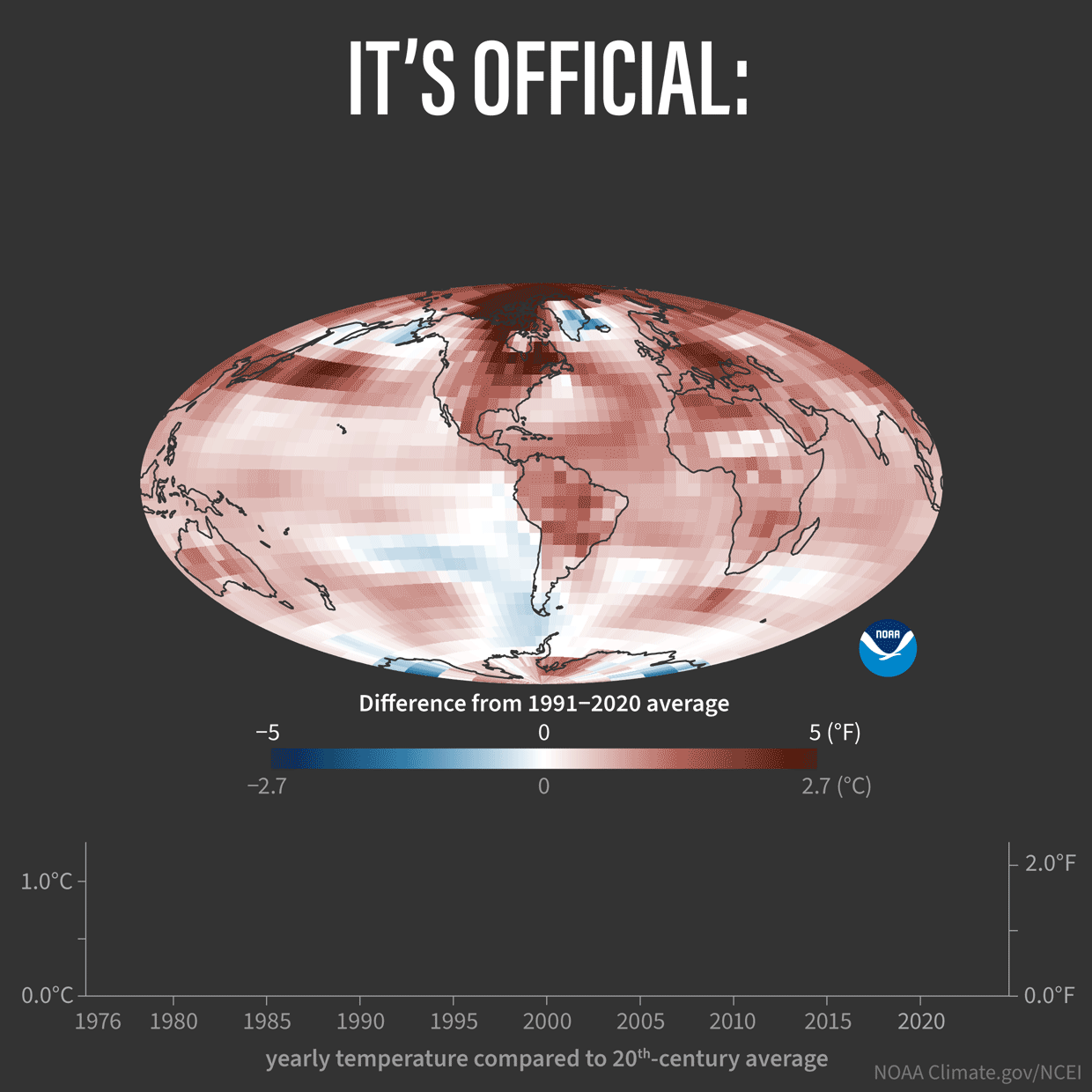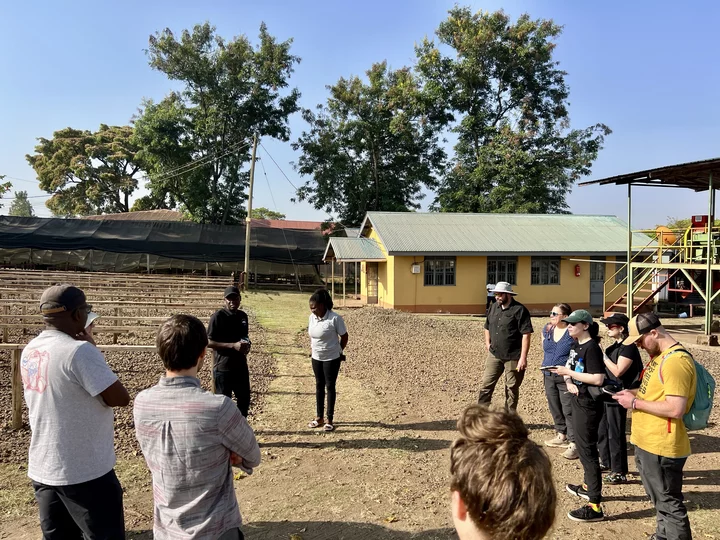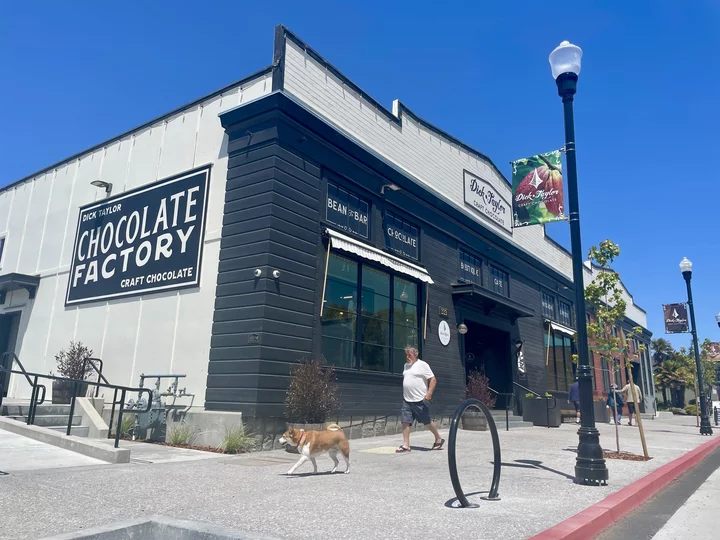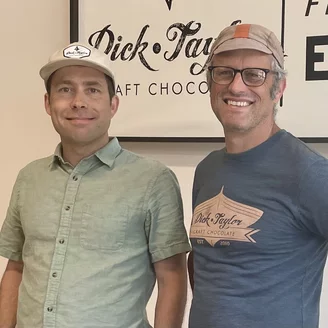Luci Ramirez (on right in blue shirt with white polka dots) and Thomas Carter (black button-up), owners of Humboldt Bay Coffee Company, listen to a presentation on coffee processing at Sironko Station in Uganda. | Submitted.
###
A few months ago, Luci Ramirez and Thomas Carter, owners of Humboldt Bay Coffee Company and Familia Coffee, flew to Tanzania, where they attended the weeklong African Fine Coffees Association Conference and Exhibition. While there, they spoke with farmers about the crazy weather conditions they’ve been dealing with: torrential rains at abnormal times, unexpected hail and sudden freezes.
They also went to Uganda, where they experienced some of this schizophrenic weather for themselves.
“It was February, sunny and hot, and then all of a sudden there was a torrential downpour,” Ramirez recalled. “The native people there say this has been happening more and more.” During such downpours, flowers get knocked off the glossy, dark leaves of the coffee plants. Those dropped blooms will never mature into drupes (or “cherries”), each of which holds a pair of the seeds we know as coffee beans.
Ramirez and Carter buy beans from a farm in Uganda whose owners expected to produce 15 containers of beans for the year, but due to the chaotic weather — which scientists attribute to human-caused climate change — they wound up with only seven, less than half of what they’d anticipated.
“If you’re a farmer in that situation, you have to feed your family by selling your crop, so the cost has to go up,” Ramirez said.
This climate-induced jolt to the global coffee trade’s supply and demand is not just happening in Africa. Brazil, the world’s largest coffee producer, is suffering its worst drought in 70 years. That combined with frost and wildfires have damaged as much as one-fifth of arabica coffee producers’ growing areas in the country, Colorado economist Billy Roberts recently told the Associated Press. Extreme weather has also led to poor harvests in Colombia and Vietnam, the latter of which is the world’s second-largest coffee producer. The resulting global coffee shortage has led to the highest wholesale prices in 13 years, according to the International Coffee Organization.
“Everybody in the coffee business is dealing with this; it doesn’t matter how big or small you are,” Ramirez said. “One of the biggest things happening is that the back stock in Brazil is being bought out by huge producers doing commercial coffee. When those [reserves] start to go down, it creates a panic in the market, which makes prices go up [even more].”
Chris Nichols, owner of Muddy Waters Coffee Company in McKinleyville, said the price of coffee has increased by 40 percent this year, mostly due to the effects of climate change and drought in Brazil and Vietnam. The coffee he buys doesn’t come from either of those countries, but the global scarcity impacts wholesale costs across the entire market.
“I’m doing my best to keep our price as low as possible,” Nichols said. But he’s been forced to raise consumer prices by about $1 to $1.25 per pound, and he’s now charging 25 percent more on sales to Costco, which carries Muddy Waters coffee in 30 of its warehouse locations.
Ramirez and Carter (on the right, behind the woman in the yellow shirt) with coffee farmers, executives and fellow roasters in Uganda. | Submitted.
Tariffs
In the midst of these global market pressures, the Trump administration has enacted a 10 percent tariff on nearly all coffee imports, with even steeper rates for some countries — including a 46 percent hike for Vietnam — though there’s currently a 90-day pause on those higher rates.
“We already got a tariff bill,” Ramirez said. “It’s the reality of what we’re dealing with.” The coffee she buys at four dollars per pound now costs $4.40, plus freight, importers’ fees and other costs. Twenty percent of the raw beans’ weight is then lost during the roasting process, making each bean even more expensive.
“Our base cost was around four dollars [per pound] a year ago; we’re now looking at seven dollars [per pound] because everything’s getting exponentially more expensive,” Ramirez said.
It’s a lot to explain to the customers who balk at the increased cost of a 12-ounce pour-over at Familia, the gourmet coffee cafés Ramirez and Carter own in Arcata and Eureka. The cafés have been suffering more than the wholesale coffee business as coffee drinkers deal with inflation and increased food prices.
“I feel like we’re all just hanging on, trying to figure out what will happen,” Ramirez said in reference to both her own company and other Humboldt County’s coffee roasters.
Dick Taylor Craft Chocolates’ factory on First Street in Old Town Eureka. | Photo by Ryan Burns.
Chocolate
Meanwhile, another tropical commodity crop is also suffering the effects of global climate change: cacao trees, which grow the cocoa beans used in chocolate production.
“Sixty to seventy percent of the cocoa in the world is grown in the Ivory Coast and Ghana,” said Adam Dick, co-owner of Eureka-based Dick Taylor Craft Chocolates. “So if you have a climate problem in that very small area of the globe, it throws cocoa in particular into a huge upheaval.”
That’s exactly what’s been happening in recent years, as rising temperatures and shifting rainfall patterns have led to heat stress and disease, resulting in smaller pods and decreased yields. As with the coffee market, the shortage is causing prices to skyrocket. They quadrupled last year and recently reached a 50-year high.
“When we first were buying cocoa and getting started, the commodity price was trading at about $2,500 a ton, and we were paying probably close to $6,500 for the [specialty] stuff that we were buying,” Dick said. “Now, the most recent orders from Belize, with the tariff on top of it, of course, it’s gonna be just above $18,000 a ton. … It’s pretty hard to fathom those numbers. Every time I buy cocoa, it’s like the same price as buying a car.”
Asked how the company can absorb such steep cost increases without a similar near-tripling of prices for consumers, Dick said that’s a good question.
“Honestly, this feels like such uncharted territory,” he said. “You’re forced to look at all other areas of the business and [find] ways that you might be able to cut costs.”
Dick and his business partner, Dustin Taylor, contacted their bank to arrange longer-term financing for the more expensive bulk purchases. Earlier this year they also raised prices on their line of craft chocolate products, and they’ve worked to reduce labor and packaging costs — for example, by redesigning their cases so each one has less material and is easier to assemble. Boxes that used to take 45 seconds to put together can now be assembled in less than five, which adds up over the course of thousands and thousands of units. Labor is Dick Taylor’s second-most expensive part of the business.
“I don’t want to get rid of employees, but I want to make sure that the employees that I do have are working as efficiently as possible so that we can stretch those hours further and further,” Dick said. And unlike Ramirez, whose cafés are struggling, the espresso and treats counter at Dick Taylor’s relatively new chocolate factory on First Street has helped to offset the increased wholesale costs.
Still, Dick said that the double-whammy of cost hikes and tariffs have slowed the business’s momentum.
“This feels like we’ve had, like, fetters put on our legs,” he said.
The tariffs in particular don’t make sense to Dick because, as with coffee, there’s not nearly enough domestic supply to replace imports for the industry. (Hawaii and Puerto Rico produce both cacao and coffee, but its production represents a tiny fraction of domestic demand.)
“And so, really, by putting a tariff on cacao you’re just shooting the whole chocolate industry in the foot,” Dick said, “because I couldn’t find an alternate U.S. source that would be viable or price competitive.”

Map of global average surface temperature in 2024 compared to the 1991-2020 average, with places that were warmer than average colored red, and places that were cooler than average colored blue. | NOAA Climate.gov, using NOAA NCEI data.
Long-term outlook
The impacts of human-caused climate change are only expected to worsen, with longer, more intense heat waves along with droughts, wildfires and extreme rainfall. Ramirez said she doesn’t expect wholesale coffee prices to decline anytime soon.
“There’s part of me that wants to believe they’ll go down but I don’t believe they will. I really don’t,” she said. “Another thing to factor in coffee farming: the kids of these farmers are no longer interested in farming because there’s no money in it. It’s a lot of work, and most of them are not getting the satisfaction of knowing where the product goes.”
The average age of coffee farmers in Mexico is 54, and in Africa it’s around 60.
“I am worried about it, by a lot … ,” Ramirez said. “We’ve always been very committed to making a great cup of coffee in the morning accessible to people. I want them to be able to Frankenstein to the coffee pot and still have a great cup.”
She’s also worried about the retirees on fixed incomes who come in to buy their pound of coffee each week. “I have to figure out how to get them their coffee … but I can’t go out of business, either,” Ramirez said.
Dick said he expects the price of cacao to come back down some, though he doesn’t expect the commodity price to ever return to what it was. In the chocolate industry, farmers are typically “the ones that lose,” getting paid the least out of anyone in the supply chain, he said. But for Dick Taylor’s specialty suppliers, the recent price hikes have actually been beneficial. The suppliers the company purchases from documents payment amounts all the way back to the gate price — the “cash on the barrelhead” paid to farmers.
“The price that they’re paid … it is astronomical right now, which is wild,” Dick said. But it’s good for the industry. “That incentivizes them to grow more cocoa, which will alleviate the supply shortage.”
Not immediately, though. Cacao trees take about three years to start producing. Still, Dick expects prices to come down, and he’s thankful that they probably won’t go as low as they used to be.
“It’ll still stay, you know, higher than it was, which will be better for the farmers,” he said. “And we’ll just have to figure out, cost-wise, how to make that work.”
Meanwhile, for the next few years at least, global temperatures are expected to remain at or near record highs.





CLICK TO MANAGE